Gameplay-wise, FIFA 07 Soccer is solid and a blast to play. It can be frustrating (patience, grasshopper), but rewarding when played correctly. Add in a REAL leagues system that is rewarding in both a singular and communal sense, plus a re-engineered Manager Mode, and you have one stout soccer offering in FIFA 07 Soccer.
Graphics and Audio
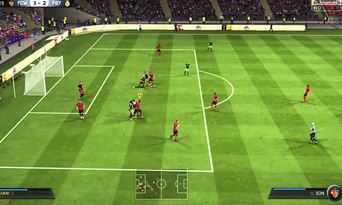
 You can already guess that FIFA 07 Soccer is not a looker. It’s actually a decent looking game, but the next-gen has swarmed us with beauty, thus making it hard to go back to low-res. But I actually like what EA did with FIFA 07 Soccer. They prioritized the animations and game action, and worried about the prettiness second. This means that the game functions nearly perfectly (no lag, no frame rate issues, and smooth animations), and looks so-so in the process. The visuals lack a bit of pizzazz. You can see the crowd, but they look like those faceless people in The Wall. You can see player shadows, but they’re blurry. The important fact is that you can see what matters in order to make intelligent decisions while playing; a no-nonsense graphical approach.
You can already guess that FIFA 07 Soccer is not a looker. It’s actually a decent looking game, but the next-gen has swarmed us with beauty, thus making it hard to go back to low-res. But I actually like what EA did with FIFA 07 Soccer. They prioritized the animations and game action, and worried about the prettiness second. This means that the game functions nearly perfectly (no lag, no frame rate issues, and smooth animations), and looks so-so in the process. The visuals lack a bit of pizzazz. You can see the crowd, but they look like those faceless people in The Wall. You can see player shadows, but they’re blurry. The important fact is that you can see what matters in order to make intelligent decisions while playing; a no-nonsense graphical approach.
FIFA games tend to excel in audio due to the excellent play-by-play programming and delivery. The same holds true for FIFA 07 Soccer, as the broadcast delivery is stellar, perfectly tracking the action and coming with an exciting punch. The crowds have been made a bigger part of the game in FIFA 07 Soccer too, as they seem much more into the action. They’ll cheer and jeer depending on the situation, and even kick a few chants when the situation presents itself. And the international soundtrack is excellent too, just as it has been in the last few FIFA SKUs.
The Bottom Line
I’ve been a die-hard Winning Eleven fan for some time now, but my allegiance to Konami’s famed series has taken a hit. FIFA 07 Soccer is the best EA soccer game to date, coming very close to the refinement of the WE series, and even eclipsing it in many areas.
Pick this one up for sure if you are looking for your favorite stars battling it out in a realistic manner. The Interactive Leagues is worth the price of admission, too. You may be a little let down by the graphics, but if you can trudge through those, you’ll be pleasantly surprised at just how solid a game FIFA 07 Soccer is.
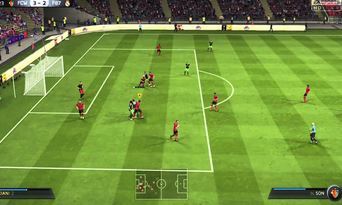 The shooting mechanic has been revamped as well, taking player context and skill into effect. Having Henry blast one is a good thing, but not if he is well marked. Player skill will rarely outdo an open shot and one with momentum towards the goal. The power gauge is also more sensitive this time around, which means it takes a fair amount of skill to get one on net and not over-hit it. I’m not sure if the new system is more or less realistic (as the pros make it looks easy), but it will definitely take more patience to master shots in FIFA 07 Soccer.
The shooting mechanic has been revamped as well, taking player context and skill into effect. Having Henry blast one is a good thing, but not if he is well marked. Player skill will rarely outdo an open shot and one with momentum towards the goal. The power gauge is also more sensitive this time around, which means it takes a fair amount of skill to get one on net and not over-hit it. I’m not sure if the new system is more or less realistic (as the pros make it looks easy), but it will definitely take more patience to master shots in FIFA 07 Soccer.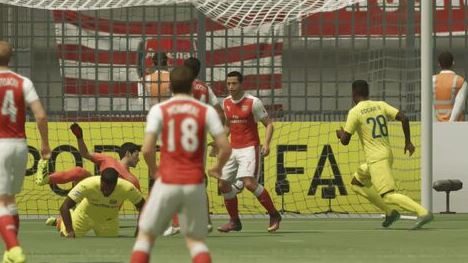 Soccer fans came out of the woodwork for this year’s World Cup. Heck, even U.S. citizens watched the cup, even though the hopeful home team had to take its international medicine.
Soccer fans came out of the woodwork for this year’s World Cup. Heck, even U.S. citizens watched the cup, even though the hopeful home team had to take its international medicine. So, looking at the list of writers for
So, looking at the list of writers for  When I did the blog four years ago, I split them up into three parts because I thought you guys would need the split since it was going to be a long blog. I’ve since been proven that my blogs should be as long as I want them to be, so skip the splits. I’ve also included two other signs that I somehow missed (or rather, never elaborated on with one of them) and I’ll talk about those missing signs in a little bit. What I can tell you before I get to the list is that I will be less critical of Mass Effect 3 than I was four years ago, but some of those signs still burn. I’ll also list the signs the same way as I did before, so let’s get to the first sign that Mass Effect 3 was going to be a disappointment before it came out!
When I did the blog four years ago, I split them up into three parts because I thought you guys would need the split since it was going to be a long blog. I’ve since been proven that my blogs should be as long as I want them to be, so skip the splits. I’ve also included two other signs that I somehow missed (or rather, never elaborated on with one of them) and I’ll talk about those missing signs in a little bit. What I can tell you before I get to the list is that I will be less critical of Mass Effect 3 than I was four years ago, but some of those signs still burn. I’ll also list the signs the same way as I did before, so let’s get to the first sign that Mass Effect 3 was going to be a disappointment before it came out!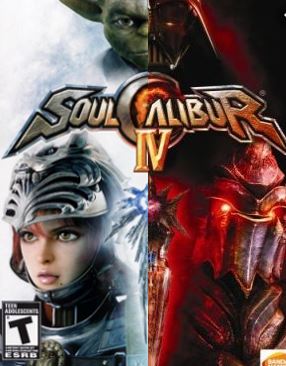 With plenty of new characters, tons of moves, and a complex new character creation and item system, you’ll find yourself digging deep into building and customizing your favorite new fighter – either make one from scratch or tweak an existing combatant, then choose between any of them at the character select screen. Before long you’ll be fiddling with monocles, trying to figure out how to lose 5 Gauge stat and gain 10 Special in order for that new special ability, and fighting your way to victory in both online and offline matches.
With plenty of new characters, tons of moves, and a complex new character creation and item system, you’ll find yourself digging deep into building and customizing your favorite new fighter – either make one from scratch or tweak an existing combatant, then choose between any of them at the character select screen. Before long you’ll be fiddling with monocles, trying to figure out how to lose 5 Gauge stat and gain 10 Special in order for that new special ability, and fighting your way to victory in both online and offline matches. Two other systems, not accessible during the first several hours of play, are the “Monster Scout” system and the “Alchemy” system. Some high-level monsters are visible on the world map — defeat them, and they may join your party! Alchemy lets you combine two items to create a new one. Hints around the world provide clues about valid recipes; also, the Alchemy system tells you in advance whether or not two items can be successfully combined, saving you from using reagents unnecessarily.
Two other systems, not accessible during the first several hours of play, are the “Monster Scout” system and the “Alchemy” system. Some high-level monsters are visible on the world map — defeat them, and they may join your party! Alchemy lets you combine two items to create a new one. Hints around the world provide clues about valid recipes; also, the Alchemy system tells you in advance whether or not two items can be successfully combined, saving you from using reagents unnecessarily.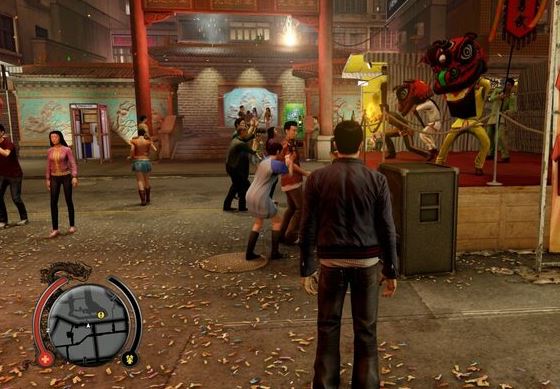 I decided to use the regular version instead of the Definitive Edition one as the regular one had the demo and I wanted to see how the regular version fared on my PC. I’m disappointed that the full game has a benchmark mode and not the demo, so I used the benchmark tool to see where I was at. I was at around 85-95 frames-per-second and that’s with the options turned on at the max (except Motion Blur as I had that option disabled because fuck Motion Blur!). When I say “at the max”, I’m including anti-aliasing as well.
I decided to use the regular version instead of the Definitive Edition one as the regular one had the demo and I wanted to see how the regular version fared on my PC. I’m disappointed that the full game has a benchmark mode and not the demo, so I used the benchmark tool to see where I was at. I was at around 85-95 frames-per-second and that’s with the options turned on at the max (except Motion Blur as I had that option disabled because fuck Motion Blur!). When I say “at the max”, I’m including anti-aliasing as well. I had no interest in the game to begin with as I wasn’t aware about the game until controversy arrived. Even if I had known about the game, I still wasn’t interested in it as scary movies don’t scare me anymore thanks to their plots (which could’ve been easily avoided) and the fact that I haven’t seen an Aliens movie. If I had seen any Alien movie, it’s been THAT long since I’ve last seen it. Despite that, even I had to be angry at the final result as what was shown prior to now was totally different and can ruin trust from gamers to developers/publishers. That trust was going downhill anyway, but not up to this scale.
I had no interest in the game to begin with as I wasn’t aware about the game until controversy arrived. Even if I had known about the game, I still wasn’t interested in it as scary movies don’t scare me anymore thanks to their plots (which could’ve been easily avoided) and the fact that I haven’t seen an Aliens movie. If I had seen any Alien movie, it’s been THAT long since I’ve last seen it. Despite that, even I had to be angry at the final result as what was shown prior to now was totally different and can ruin trust from gamers to developers/publishers. That trust was going downhill anyway, but not up to this scale.